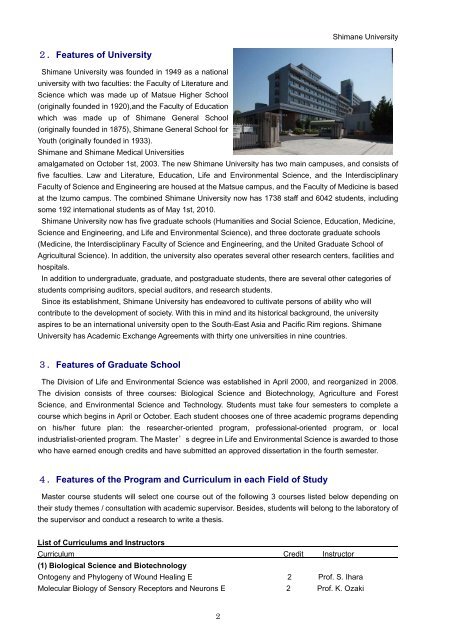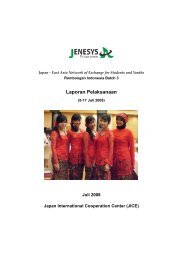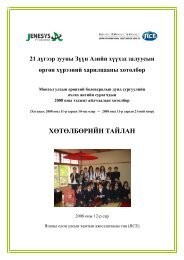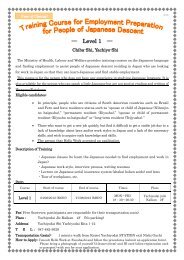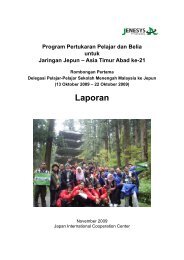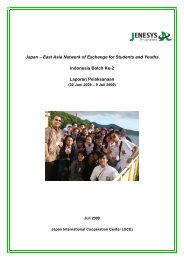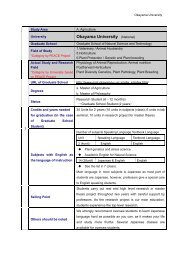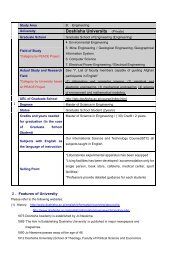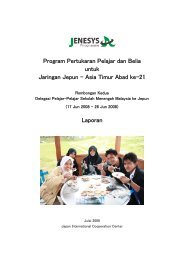Shimane University (National)
Shimane University (National)
Shimane University (National)
Create successful ePaper yourself
Turn your PDF publications into a flip-book with our unique Google optimized e-Paper software.
<strong>Shimane</strong> <strong>University</strong>2.Features of <strong>University</strong><strong>Shimane</strong> <strong>University</strong> was founded in 1949 as a nationaluniversity with two faculties: the Faculty of Literature andScience which was made up of Matsue Higher School(originally founded in 1920),and the Faculty of Educationwhich was made up of <strong>Shimane</strong> General School(originally founded in 1875), <strong>Shimane</strong> General School forYouth (originally founded in 1933).<strong>Shimane</strong> and <strong>Shimane</strong> Medical Universitiesamalgamated on October 1st, 2003. The new <strong>Shimane</strong> <strong>University</strong> has two main campuses, and consists offive faculties. Law and Literature, Education, Life and Environmental Science, and the InterdisciplinaryFaculty of Science and Engineering are housed at the Matsue campus, and the Faculty of Medicine is basedat the Izumo campus. The combined <strong>Shimane</strong> <strong>University</strong> now has 1738 staff and 6042 students, includingsome 192 international students as of May 1st, 2010.<strong>Shimane</strong> <strong>University</strong> now has five graduate schools (Humanities and Social Science, Education, Medicine,Science and Engineering, and Life and Environmental Science), and three doctorate graduate schools(Medicine, the Interdisciplinary Faculty of Science and Engineering, and the United Graduate School ofAgricultural Science). In addition, the university also operates several other research centers, facilities andhospitals.In addition to undergraduate, graduate, and postgraduate students, there are several other categories ofstudents comprising auditors, special auditors, and research students.Since its establishment, <strong>Shimane</strong> <strong>University</strong> has endeavored to cultivate persons of ability who willcontribute to the development of society. With this in mind and its historical background, the universityaspires to be an international university open to the South-East Asia and Pacific Rim regions. <strong>Shimane</strong><strong>University</strong> has Academic Exchange Agreements with thirty one universities in nine countries.3.Features of Graduate SchoolThe Division of Life and Environmental Science was established in April 2000, and reorganized in 2008.The division consists of three courses: Biological Science and Biotechnology, Agriculture and ForestScience, and Environmental Science and Technology. Students must take four semesters to complete acourse which begins in April or October. Each student chooses one of three academic programs dependingon his/her future plan: the researcher-oriented program, professional-oriented program, or localindustrialist-oriented program. The Master’s degree in Life and Environmental Science is awarded to thosewho have earned enough credits and have submitted an approved dissertation in the fourth semester.4.Features of the Program and Curriculum in each Field of StudyMaster course students will select one course out of the following 3 courses listed below depending ontheir study themes / consultation with academic supervisor. Besides, students will belong to the laboratory ofthe supervisor and conduct a research to write a thesis.List of Curriculums and InstructorsCurriculum Credit Instructor(1) Biological Science and BiotechnologyOntogeny and Phylogeny of Wound Healing E 2 Prof. S. IharaMolecular Biology of Sensory Receptors and Neurons E 2 Prof. K. Ozaki2


